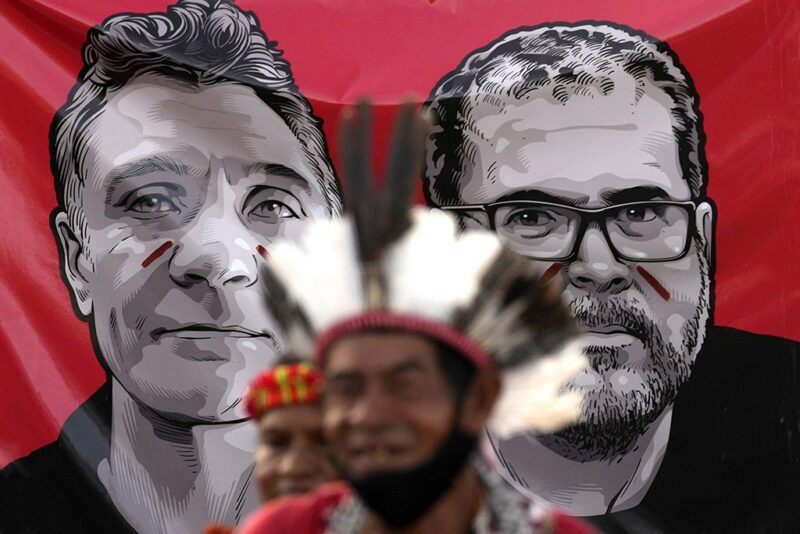AP had staff in the remote Amazon before other international media and even the federal police, setting the stage for standout all-formats coverage.

Indigenous men stand in front of images of slain British journalist Dom Phillips, left, and slain Indigenous expert Bruno Pereira in Brasilia, Brazil, June 23, 2022.
AP Photo/ Eraldo Peres
When a much-loved British journalist and an indigenous expert disappeared in the remote reaches of Brazil’s western Amazon, AP excelled in all formats. The comprehesive coverage included widely used video packages, speedy reports on breaking developments and insightful features, while avoiding the reporting mistakes of other media — all setting AP apart and earning Best of the Week — First Winner.
On the crucial first day when journalist Dom Phillips and indigenous expert Bruno Araújo Pereira were announced missing, AP staff in Brazil located a filmmaker who happened to be traveling to the remote Amazon town of Atalaia do Norte. That enabled AP to distribute locally shot video and comments from local Indigenous leaders ahead of all international media. At least two more days passed before competing agencies put out their own packages — even some major Brazilian media used AP. Mobilizing the team was a feat, due to both the difficult logistics and costs, but AP staff were on the ground well before any other international media — and before federal police arrived to investigate.
The fast start enabled AP to publish photos ahead of the competition from both Atalaia do Norte and the site where Indigenous people were searching for bodies. And while others presumed for days that the disappearance of the two men was tied to illegal gold mining or logging, AP reported, based on the staff’s knowledge of the area, that the disappearance was far more likely connected to poachers and illegal fishermen, as subsequently confirmed by investigators.
Central to AP’s all-formats coverage:
— Amazon reporter Fabiano Maisonnave and freelance photographer Edmar Barros anchored coverage from Atalaia do Norte. — Reporter Mauricio Savarese and video journalist Tatiana Pollastri in Sao Paulo, and chief photographer Silvia Izquierdo and senior video producer Chris Gillette in Rio de Janeiro, worked sources for information and quickly assembled coverage in all formats.
— Washington video editor Rosa Ramirez helped produce the video packages.
— David Biller, Brazil news director, coordinated the text report while on assignment in Ukraine, with a strong assist from Peter Prengaman, climate news director based in Phoenix.
Biller discussed the slain men’s legacies in video from Lviv, Ukraine:
Later, many foreign media ran with an incorrect story about the men’s bodies being found, citing an anonymous source. AP reporters were skeptical and avoided the trap despite intense global pressure for updates. Within hours, other media were walking back their reporting as it became clear they had been wrong.
Regional expertise was reinforced with an explainer on crime in the Javari Valley region, an exclusive breakdown of the area’s illegal fishing network and a story on allegations police tortured the suspect in custody. AP also delivered features on Phillips and Araújo Pereira that went beyond tribute pieces to provide insight into their important work, and the likely fate of their projects after their deaths.
For putting AP out front with fast, accurate, best-in-class coverage, the AP team of Maisonnave, Barros, Savarese, Pollastri, Rosa Ramirez, Izquierdo, Gillette, Biller and Prengaman earns Best of the Week — First Winner honors.
Visit AP.org to request a trial subscription to AP's video, photo and text services.
For breaking news, visit apnews.com












